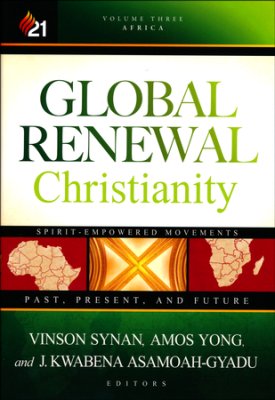Global Renewal Christianity: Africa
 Vinson Synan, Amos Yong, and J. Kwabena Asamoah-Gyadu, eds., Global Renewal Christianity: Spirit-Empowered Movements—Past, Present, and Future, Volume 3: Africa (Lake Mary, FL: Charisma House, 2016) liv+ 499 pages.
Vinson Synan, Amos Yong, and J. Kwabena Asamoah-Gyadu, eds., Global Renewal Christianity: Spirit-Empowered Movements—Past, Present, and Future, Volume 3: Africa (Lake Mary, FL: Charisma House, 2016) liv+ 499 pages.
This volume focused on the Spirit in Africa is the third in a series of now four texts. Produced for the enrichment of anyone intrigued with the phenomenon of Pentecostalism, this particular collection of articles offers scholarship of substance and depth, written to inform and to critique, a text which also concomitantly highlights the agents of this spirituality on the continent of Africa. Anyone remotely familiar with African Pentecostalism will note that many of the authors selected to contribute here are authorities speaking from within the movement itself, offering their weighty insights, firsthand observations, and care-full commentaries. Alongside of them are others who complement these selections with their own observations drawn from varied vantage points. Such a collection of material is a scholar’s feast but is equally attractive to those outside of the academies of theology, missiology, and sociology. The volume is a significant addition to what has already been written about the origins, nature, and influence of Pentecostalism in Africa and is a real treasure for anyone called to a deeper understanding of this brand of spirituality as it is found today on the continent.
The reports of the vigor and fluidity of the Pentecostal movement in so many African nations give cause for optimism.
Whence Pentecostalism in Africa? One of the many themes addressed within the book is the origin of Pentecostalism on the continent and then its appearance in various regions throughout. The subject is touched on for West Africa, in particular Ghana and Nigeria, but the book also features the less popular histories of Burkina Faso and Cameroon. Eye-opening reports on the beginnings of the movement in various places include Egypt, Ethiopia, Kenya, Tanzania, and Madagascar, among others. The consensus regarding origins is mosaic. In many contexts, Pentecostalism is better understood as a “homegrown” phenomenon where indigenous initiatives figured prominently—as in the case of Peter Anim in Ghana and Ghali Hanna in Egypt—or where neighboring African Pentecostals brought the message of Spirit renewal. Ethiopia was impacted by a Pentecostal Kenyan evangelist and Namibia was reached through South African Pentecostals. But the influence of Pentecostals who came from outside the continent is also evidenced, especially in the story of Angola (Brazilian missions figure prominently) and Botswana (American Pentecostals were key). In the case of Namibia, Pentecostal missionaries from South Africa can be traced back to the American evangelist John G. Lake.
Pentecostalism’s focus on deliverance and empowerment meets the needs of the spiritual populace.


